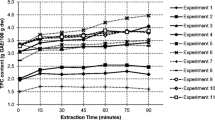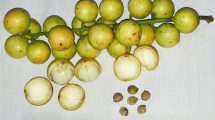Abstract
Sweet potato peels (SPP) are a major waste generated during root processing and currently have little commercial value. Phenolics with free radical scavenging activity from SPP may represent a possible added-value product for the food industry. The aqueous extraction of phenolics from SPP was studied using a Central Composite Design with solvent to solid ratio (30–60 mL g−1), time (30–90 min) and temperature (25–75 °C) as independent variables. The comparison of response surface methodology (RSM) and artificial neural network (ANN) analysis on extraction modelling and optimising was performed. Temperature and solvent to solid ratio, alone and in interaction, presented a positive effect in TPC, ABTS and DPPH assays. Time was only significant for ABTS assay with a negative influence both as main effect and in interaction with other independent variables. RSM and ANN models predicted the same optimal extraction conditions as 60 mL g−1 for solvent to solid ratio, 30 min for time and 75 °C for temperature. The obtained responses in the optimized conditions were as follow: 11.87 ± 0.69 mg GAE g−1 DM for TPC, 12.91 ± 0.42 mg TE g−1 DM for ABTS assay and 46.35 ± 3.08 mg TE g−1 DM for DPPH assay. SPP presented similar optimum extraction conditions and phenolic content than peels of potato, tea fruit and bambangan. Predictive models and the optimized extraction conditions offers an opportunity for food processors to generate products with high potential health benefits.


Similar content being viewed by others
References
Amyrgialaki E, Makris DP, Mauromoustak A, Kefalas P (2014) Optimisation of the extraction of pomegranate (Punica granatum) husk phenolics using water/ethanol solvent systems and response surface methodology. Ind Crop Prod 59:216–222
Anastácio A, Carvalho IS (2013) Phenolics extraction from sweet potato peels: Key factors screening through a Placket–Burman design. Ind Crop Prod 43:99–105
Barnes SL, Sanders SA (2012) Advances in functional use of sweetpotato, [Ipomoea batatas (L) Lam]. Recent Pat Food Nutr Agric 4:1–7
Blois MS (1958) Antioxidant determinations by the use of a stable free radical. Nature 181:1199–1200
Bovell-Benjamin AC (2007) Sweet potato: a review of its past, present, and future role in human nutrition. Adv Food Nutr Res 52:1–59
Casazza AA, Aliakbarian B, De Faveri D, Fiori L, Perego P (2012) Antioxidants from winemaking wastes: a study on extraction parameters using response surface methodology. J Food Biochem 36:28–37
Cheok CY, Chin NL, Yusof YA, Talib RA, Law CL (2012) Optimization of total phenolic content extracted from Garcinia mangostana Linn hull using response surface methodology versus artificial neural network. Ind Crop Prod 40:247–253
Dahmoune F, Moussi K, Remini H, Belbahi A, Aoun O, Spigno G, Madani K (2014) Optimization of ultrasound-assisted extraction of phenolic compounds from Citrus sinensis L peels using response surface methodology. Chem Eng 37:889–894
Gurgel CSS, Farias SMdOC, Faria LRG, Moreira RT (2011) Sensory analysis of sweet potato ice cream. Rev Bras Prod Agroindus 13:21–26
Londoño-Londoño J, Lima VRd, Lara O, Gil A, Pasa TBC, Arango GJ, Pineda JRR (2010) Clean recovery of antioxidant flavonoids from citrus peel: optimizing an aqueous ultrasound-assisted extraction method. Food Chem 119:81–87
Maloney KP, Truong VD, Allen JC (2012) Chemical optimization of protein extraction from sweet potato (Ipomoea batatas) peel. J Food Sci 77:E307–E312
Manpreet S, Sawraj S, Sachin D, Pankaj S, Banerjee UC (2005) Influence of process parameters on the production of metabolites in solid-state fermentation. Malays J Microbiol 1:1–9
Nunes R, Anastácio A, Carvalho IS (2012) Antioxidant and free radical scavenging activities of different plant parts from two Erica species. J Food Qual 35:307–314
Oyeleke SB, Dauda BEN, Oyewole OA, Okoliegbe IN, Ojebode T (2012) Production of bioethanol from cassava and sweet potato peels. Adv Environ Biol 6:241–245
Panda V, Sonkamble M, Patil S (2011) Wound healing activity of Ipomoea batatas tubers (sweet potato). Funct Food Health Dis 10:403–415
Peschel W, Sánchez-Rabaneda F, Diekmann W, Plescher A, Gartzía I, Jiménez D, Lamuela-Raventós R, Buxaderas S, Codina C (2006) An industrial approach in the search of natural antioxidants from vegetable and fruit wastes. Food Chem 97:137–150
Prakash Maran J, Manikandan S, Vigna Nivetha C, Dinesh R (2013) Ultrasound assisted extraction of bioactive compounds from Nephelium lappaceum L fruit peel using central composite face centred response surface design. Arabian J Chem. doi:10.1016/j.arabjc.2013.02.007
Prasad KN, Hassan FA, Yang B, Kong KW, Ramanan RN, Azlan A, Ismail A (2011) Response surface optimisation for the extraction of phenolic compounds and antioxidant capacities of underutilised Mangifera pajang Kosterm peels. Food Chem 128:1121–1127
Prieto P, Pineda M, Aguilar M (1999) Spectrophotometric quantitation of antioxidant capacity through the formation of a phosphomolybdenum complex: specific application to the determination of vitamin E1. Anal Biochem 269:337–341
Re R, Pellegrini N, Proteggente A, Pannala A, Yang M, Rice-Evans C (1999) Antioxidant activity applying an improved ABTS radical cation decolorization assay. Free Radical Biol Med 26:1231–1237
Saharan B, Sahu R, Sharma D (2011) A review on biosurfactants: fermentation, current developments and perspectives. Gen Eng Biotechnol J 2011:1–14
Santos DT, Meireles MAA (2011) Optimization of bioactive compounds extraction from jabuticaba (Myrciaria cauliflora) skins assisted by high pressure CO2. Innov Food Sci Emerg Technol 12:398–406
Singh A, Sabally K, Kubow S, Donnelly DJ, Gariepy Y, Orsat V, Raghavan GS (2011) Microwave-assisted extraction of phenolic antioxidants from potato peels. Molecules 16:2218–2232
Tabaraki R, Heidarizadi E, Benvidi A (2012) Optimization of ultrasonic-assisted extraction of pomegranate (Punica granatum L) peel antioxidants by response surface methodology. Sep Purif Technol 98:16–23
Wijngaard HH, Ballay M, Brunton N (2012) The optimisation of extraction of antioxidants from potato peel by pressurised liquids. Food Chem 133:1123–1130
Wireko-Manu FD, Ellis WO, Oduro I (2010) Production of a non-alcoholic beverage from sweet potato (Ipomoea batatas L). Afr J Food Sci 4:180–183
Wojdylo A, Oszmianski J, Czemerys R (2007) Antioxidant activity and phenolic compounds in 32 selected herbs. Food Chem 105:940–949
Xu P, Bao J, Gao J, Zhou T, Wang Y (2012) Optimization of extraction of phenolic antioxidants from tea (Camellia sinensis L) fruit peel biomass using response surface methodology. BioResources 7:2431–2443
Zhu F, Cai YZ, Yang X, Ke J, Corke H (2010) Anthocyanins, hydroxycinnamic acid derivatives, and antioxidant activity in roots of different chinese purple-fleshed sweetpotato genotypes. J Agric Food Chem 58:7588–7596
Author information
Authors and Affiliations
Corresponding author
Ethics declarations
Conflicts of interest
The authors declare that there is no conflict of interest.
Electronic supplementary material
Below is the link to the electronic supplementary material.
Rights and permissions
About this article
Cite this article
Anastácio, A., Silva, R. & Carvalho, I.S. Phenolics extraction from sweet potato peels: modelling and optimization by response surface modelling and artificial neural network. J Food Sci Technol 53, 4117–4125 (2016). https://doi.org/10.1007/s13197-016-2354-1
Revised:
Accepted:
Published:
Issue Date:
DOI: https://doi.org/10.1007/s13197-016-2354-1




